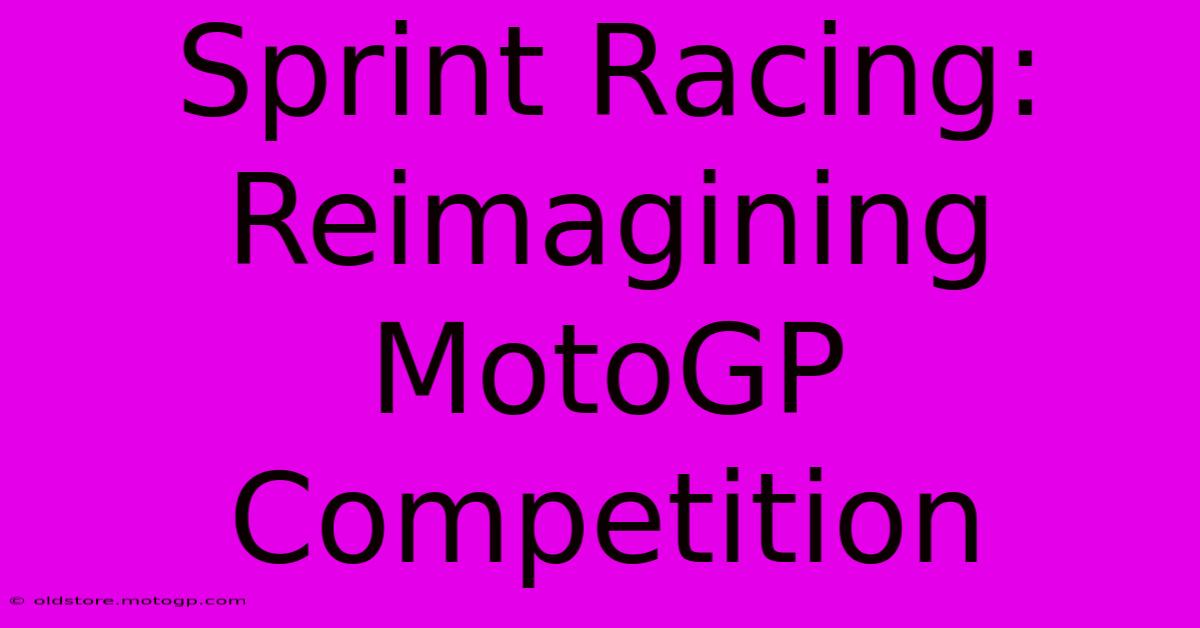Sprint Racing: Reimagining MotoGP Competition

Table of Contents
Sprint Racing: Reimagining MotoGP Competition
MotoGP, the pinnacle of motorcycle racing, is constantly evolving. In recent years, one of the most significant changes has been the introduction of Sprint Races. This addition to the Grand Prix weekend format has sparked considerable debate, reimagining the very nature of competition and captivating audiences worldwide. But what exactly are Sprint Races, and how have they impacted the sport? Let's delve into the details.
What are Sprint Races in MotoGP?
Sprint Races are shorter, faster races held on Saturday afternoon, preceding the main Grand Prix race on Sunday. They typically last around a half the distance of the main race, offering a thrilling, high-octane spectacle that adds another layer of excitement to the weekend. Points are awarded to the top nine finishers, though the points allocation differs from the Sunday race (typically half the points).
How Sprint Races Change the Game:
The introduction of Sprint Races has undeniably altered the dynamics of MotoGP competition in several key ways:
-
Increased Track Time: Teams and riders now have significantly more track time during the weekend, allowing for greater data collection and bike setup adjustments. This can lead to more informed strategic decisions for the main race.
-
Elevated Stakes: Every session now carries added weight. A strong performance in the Sprint Race can boost confidence, provide valuable track position for Sunday's main event, and secure crucial championship points. Conversely, a poor performance can significantly impact a rider's weekend.
-
Strategic Gameplay: The shorter distance of the Sprint Race encourages more aggressive riding strategies. Riders may be more willing to take risks, leading to exciting overtakes and unexpected results. This adds another layer of unpredictability and excitement.
-
Enhanced Fan Engagement: The Sprint Race provides fans with an additional opportunity to witness the intense competition, ultimately increasing overall engagement and excitement around the MotoGP weekend.
The Pros and Cons of Sprint Races
While Sprint Races have been largely well-received, they haven't been without their critics. Let's examine the key arguments:
Advantages:
- More Action, More Excitement: The shorter race format often delivers more intense and unpredictable action.
- Increased Championship Intensity: Points awarded in the Sprint Race add another layer of complexity and pressure to the championship battle.
- Improved Fan Engagement: The extra racing provides more value for spectators and viewers.
- More Data for Teams: The extra track time benefits teams in optimizing bike setups and race strategies.
Disadvantages:
- Increased Tire Wear: The extra racing can lead to increased tire wear, potentially impacting the main race performance.
- Higher Risk of Injury: More racing naturally translates to a heightened risk of accidents and injuries for riders.
- Potential for Exhaustion: The extra demands on riders and teams may lead to fatigue and reduced performance in the main race.
- Over-saturation: Some argue that the addition of a Sprint Race leads to an over-saturation of racing, potentially diminishing the impact of the main Grand Prix.
The Future of Sprint Races in MotoGP
The long-term impact of Sprint Races on MotoGP remains to be seen. While some aspects require ongoing evaluation and potential adjustments (such as points allocation and tire management), their current popularity suggests they're here to stay. The added excitement and strategic depth they've injected into the sport make them a significant and likely permanent part of the future of MotoGP competition. Their evolution will certainly be a fascinating story to follow for years to come. As the sport continues to evolve, adapting to feedback from riders, teams, and fans, the Sprint Race format will undoubtedly refine itself to create an even more compelling and enjoyable experience for all.
Conclusion: A New Era of MotoGP
The introduction of Sprint Races marks a significant shift in the landscape of MotoGP. It has injected a renewed sense of excitement and unpredictability into the sport, engaging fans and adding a layer of complexity for riders and teams alike. While challenges remain, the overall positive impact of Sprint Races on the MotoGP experience seems undeniable. The future of MotoGP racing will undoubtedly be shaped, in part, by the continued evolution and refinement of this exciting new format.

Thank you for visiting our website wich cover about Sprint Racing: Reimagining MotoGP Competition. We hope the information provided has been useful to you. Feel free to contact us if you have any questions or need further assistance. See you next time and dont miss to bookmark.
Featured Posts
-
Get Ready To Race Moto Gp 23 Ps 5 Launch Trailer
Feb 22, 2025
-
How Moto Gp Sprintrennen Will Affect Rider Strategy
Feb 22, 2025
-
Moto Gp Aero The Quest For Speed And Stability
Feb 22, 2025
-
Mastering Moto Gp Qualifying Everything You Need To Know
Feb 22, 2025
-
Moto Gp Austin 2025 Get Closer To The Action
Feb 22, 2025
